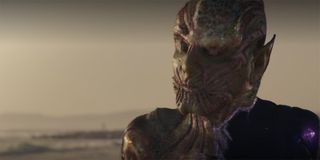Captain Marvel Filmmakers Explored Some Super Weird References For The Skrulls Transformations

The Marvel Cinematic Universe has brought a number of well-loved alien species from the comics to the big screen over the years, but few were more anticipated than the arrival of the Skrulls. Since their introduction in the early 1960s, the shape-shifting extraterrestrials have been a favorite among fans, and years were spent speculating about when they would finally get the blockbuster treatment.
Of course, the Skrulls got their moment last year with the release of Captain Marvel – but their inclusion in that movie created a number of interesting challenges for the filmmakers involved. One key query was in regard to the look of the transformation each character would undergo as they took on the form of another, and this led them to explore some fun and weird reference material as they were trying to figure out the answer.
Earlier this week I participated in a visual effects press day on the Walt Disney Pictures lot in Burbank, California, and it was while speaking with the team behind Captain Marvel that I learned about how the film figured out the way the transformation of the Skrulls would appear. The work was accomplished by the effects house Digital Domain, and Visualization Supervisor Shannon Justison detailed how the studio worked with them and directors Anna Boden and Ryan Fleck in that specific department:
Anna and Ryan had very specific thoughts. They didn't want it to be magical. They didn't want it to be like Mystique in X-Men. They didn't want it to just be a fade. They didn't want it to just be morph. They wanted to do it very visceral.
With the directors being clear about what they didn’t want the transformation of the Skrulls to look like, what was left was determining the unique way Captain Marvel would present it, and that part of the process led down some surprising avenues.
On one hand there were the cinematic references – with a focus on movies that came out around the same era in which the Marvel Studios film is set: the early 1990s (a time when the industry was much more special effects oriented and didn’t have the flawless look of today’s CGI). They didn’t stop there, though. Said Shannon Justison,
They wanted us to look at Teen Wolf, and that's what we were looking at. So like old school, practical transformations that they were doing back in the '80s and '90s before we could do everything all fancy and smooth in CG. And then we just looked up some crazy references. We looked at like high-speed popcorn popping, which is actually incredibly weird to look at. Look it up; it's weird. I remember that was a big favorite when we came across that one.
Further inspiration was taken from nature. Leaning into the fact that the Skrulls have a reptilian-like appearance (their transformative abilities reminiscent of a chameleon), some Lacertilia-centric research was performed, and helped the teams get an idea of the specificity in the look:
And then looking at different animals that do shed their skin. Technically the Skrulls are reptilian in a way. They didn't want it to feel just like a skin shed, but still it's interesting reference. So there was a lot of different ways of like, 'Okay, how does the skin part?' And, 'Is it a pattern? Is it random?'
Shannon Justison’s comments made it sound like there was no specific piece of reference material that dominated the discussion, but that, frankly, goes a long way in explaining why there is no perfect direct comparison for what the Skrulls transformation in Captain Marvel looks like.
CINEMABLEND NEWSLETTER
Your Daily Blend of Entertainment News
One additional aspect of the conversation that was interesting, though, was the fact that the filmmakers agreed that it didn’t exactly have to look pretty. While the Skrull race considers the ability to turn into other beings and objects an art form, it’s not really a beautiful thing to look at while it’s happening. There were certain limits on how far this concept could be pushed, but Justison explained,
They did want a little bit of like a grossness factor. They didn't want it to be too pretty or clean. So there was a lot of explorations of like, how do we make it gross without going too gross, because it still needs to be PG-13, and we don't want to throw people off too bad because even though these are sorta bad guys, eventually they're not.
Audiences everywhere can now enjoy the finished result, as Captain Marvel is not only available for purchase digitally and on 4K, Blu-ray and DVD, but also streaming on Disney+.

Eric Eisenberg is the Assistant Managing Editor at CinemaBlend. After graduating Boston University and earning a bachelor’s degree in journalism, he took a part-time job as a staff writer for CinemaBlend, and after six months was offered the opportunity to move to Los Angeles and take on a newly created West Coast Editor position. Over a decade later, he's continuing to advance his interests and expertise. In addition to conducting filmmaker interviews and contributing to the news and feature content of the site, Eric also oversees the Movie Reviews section, writes the the weekend box office report (published Sundays), and is the site's resident Stephen King expert. He has two King-related columns.
Most Popular




